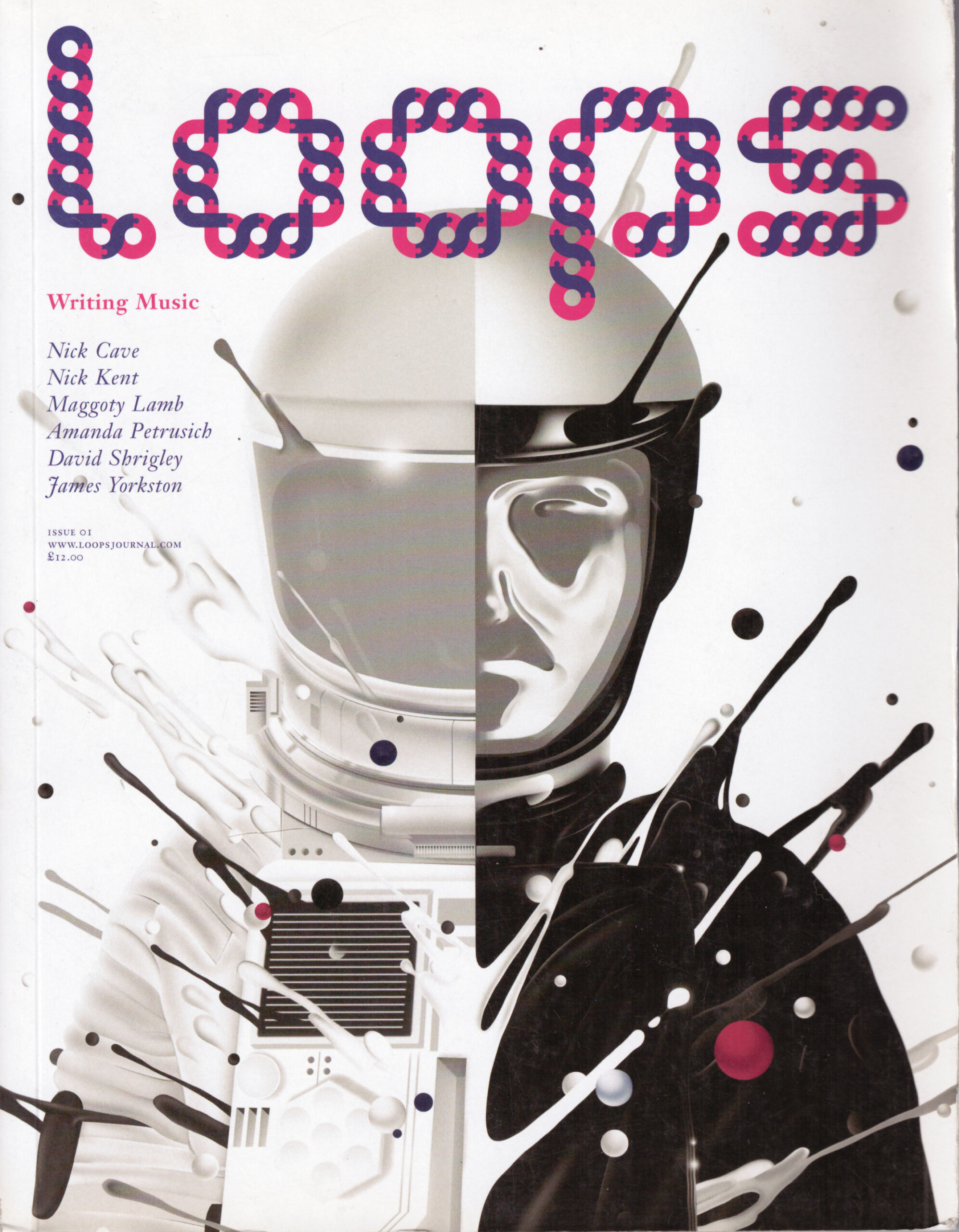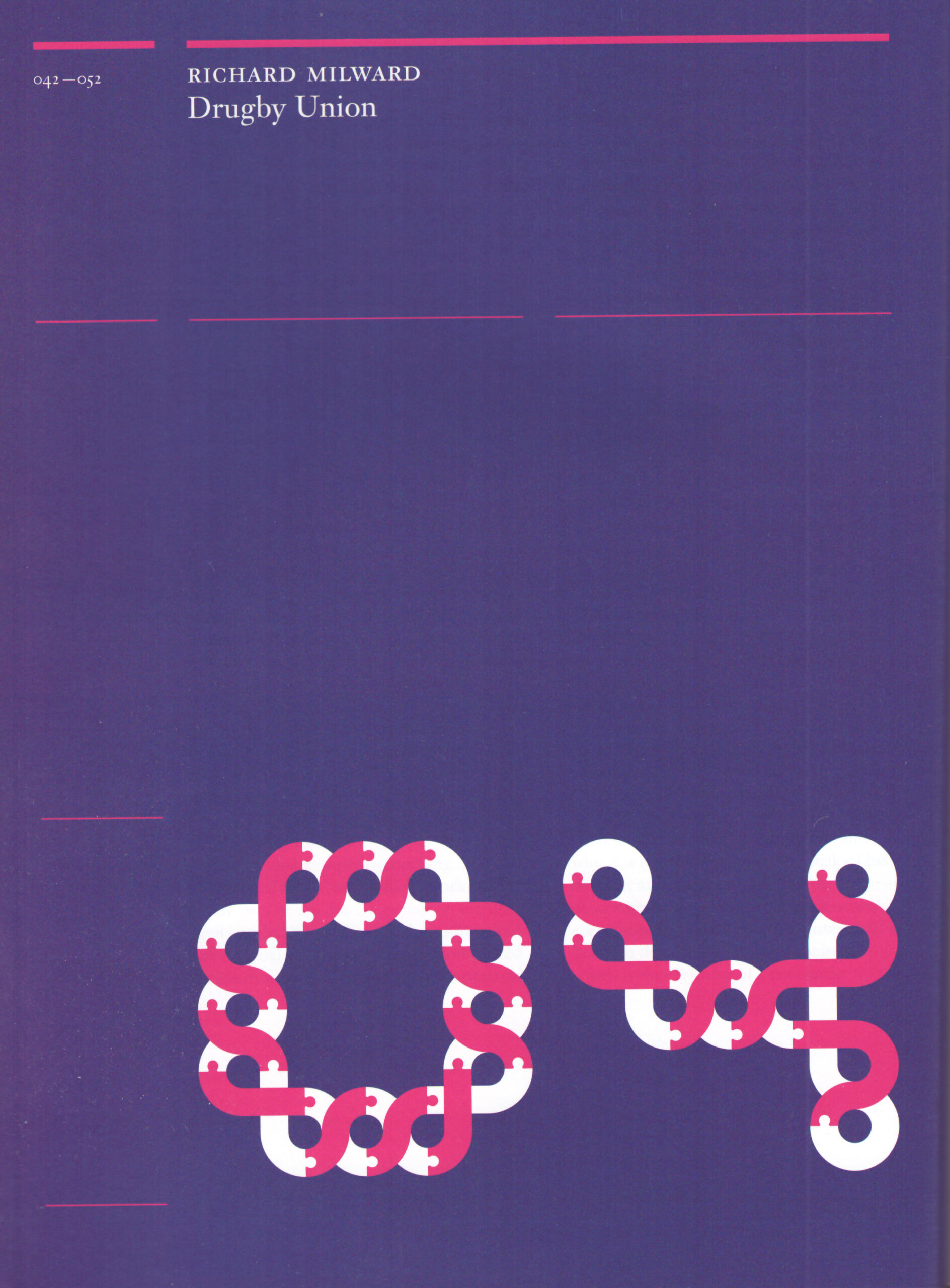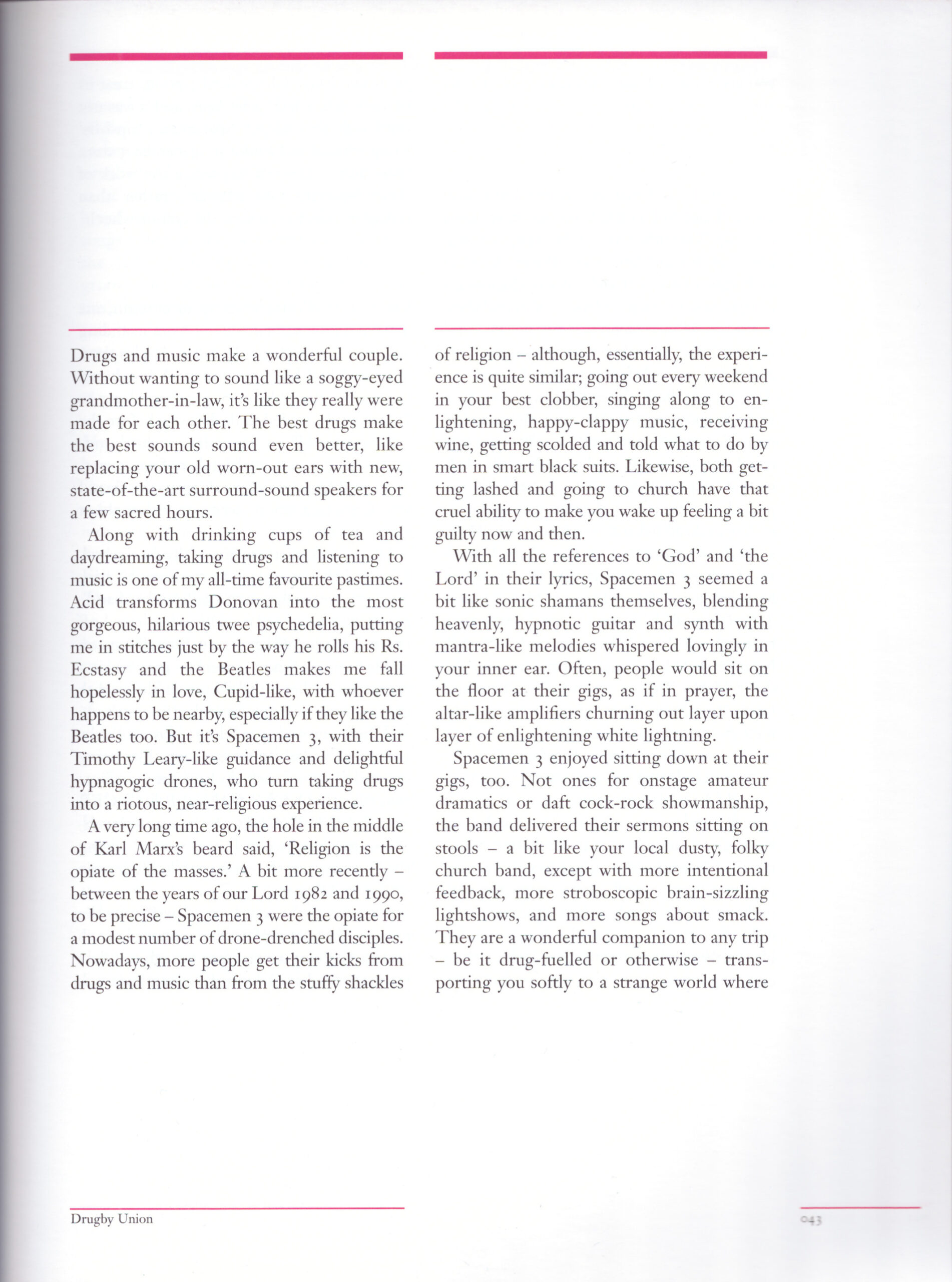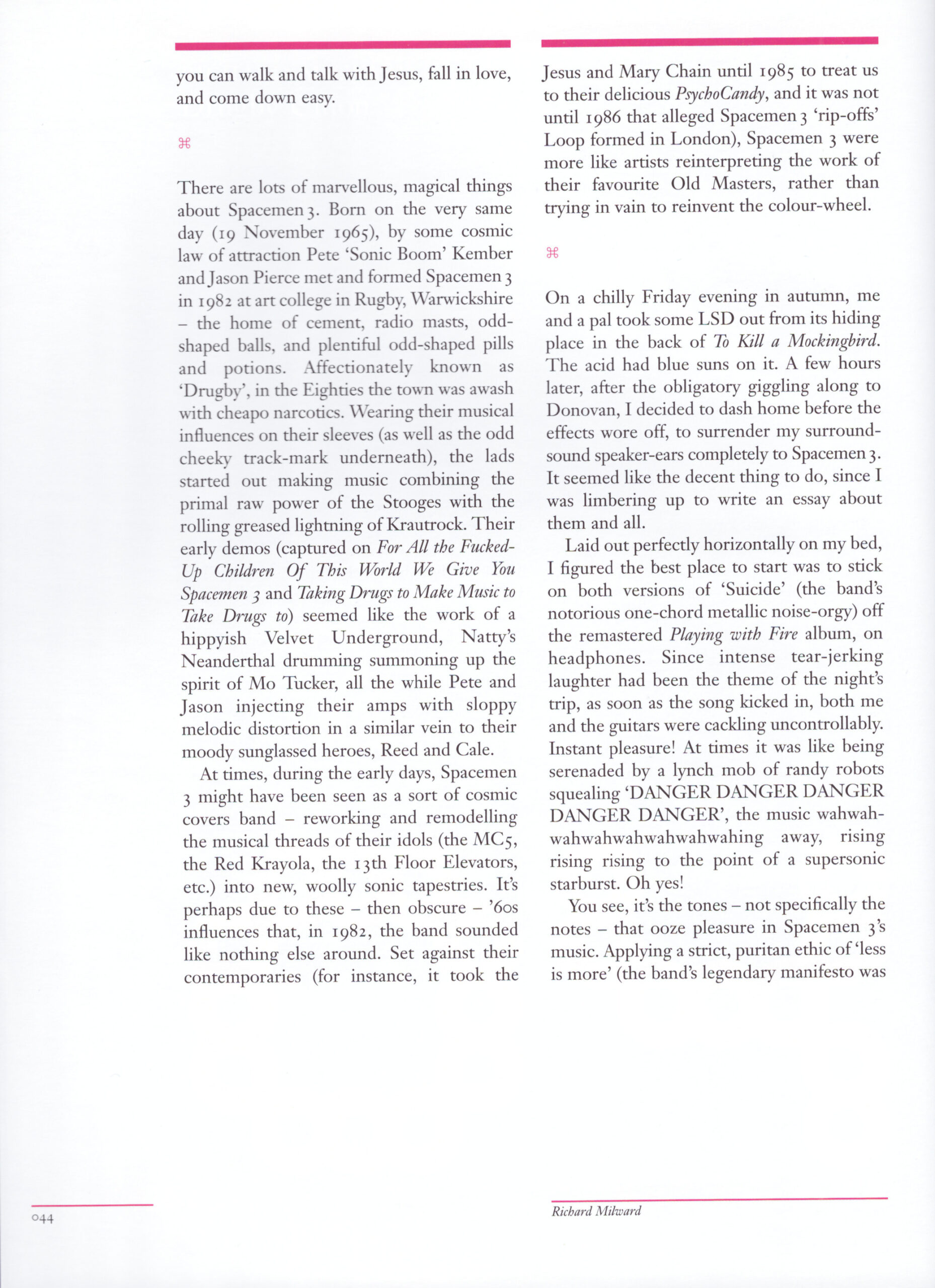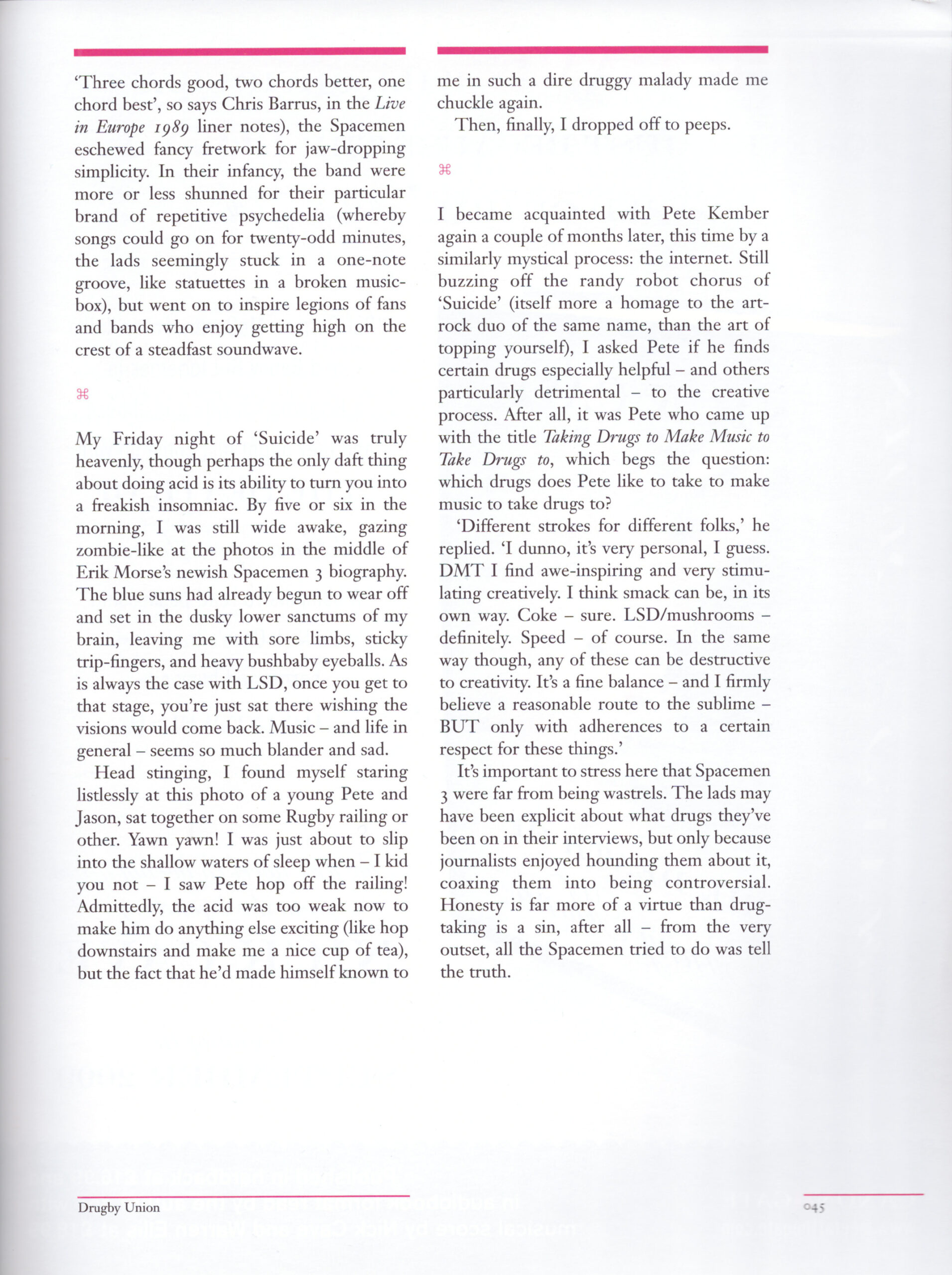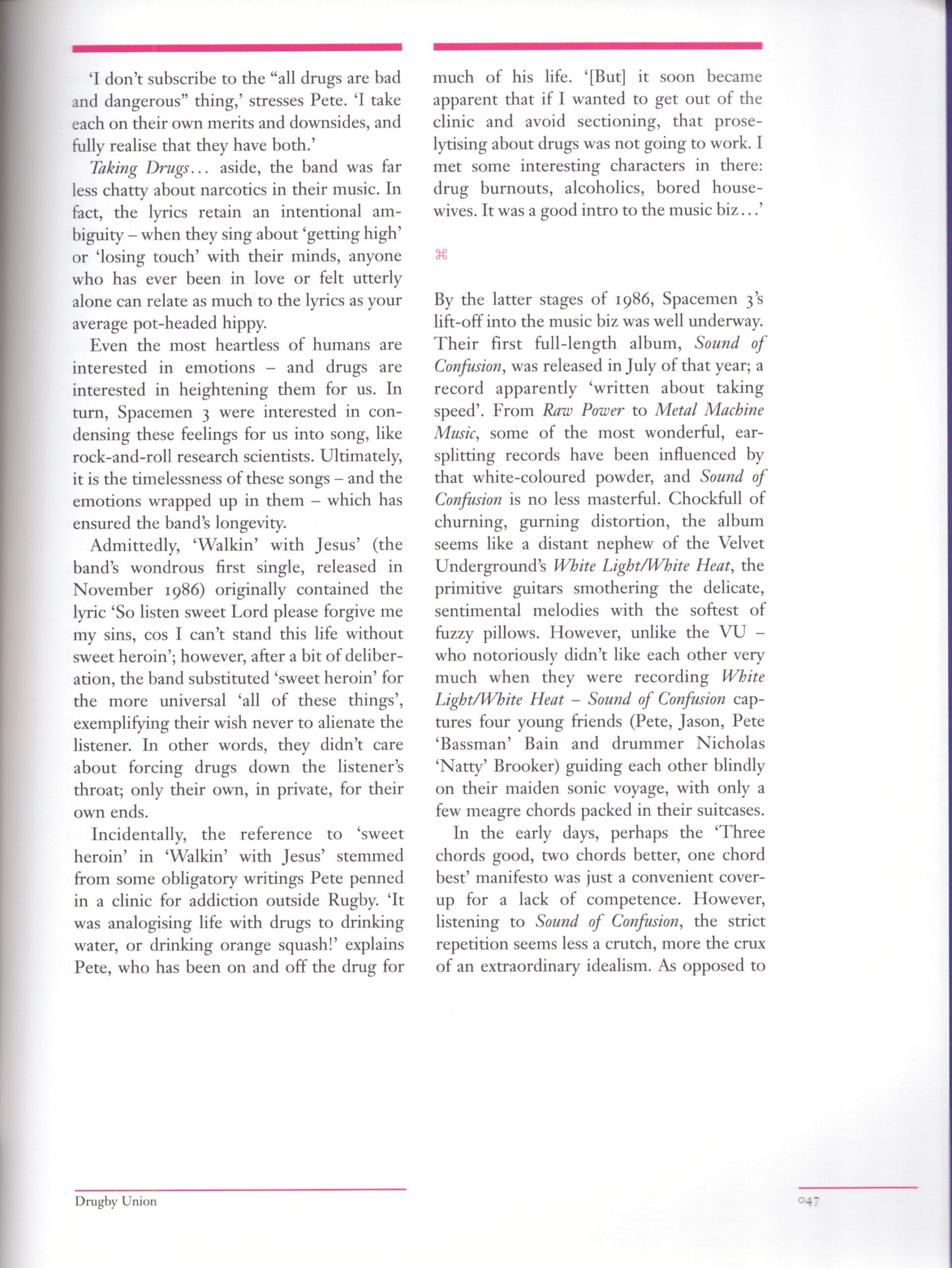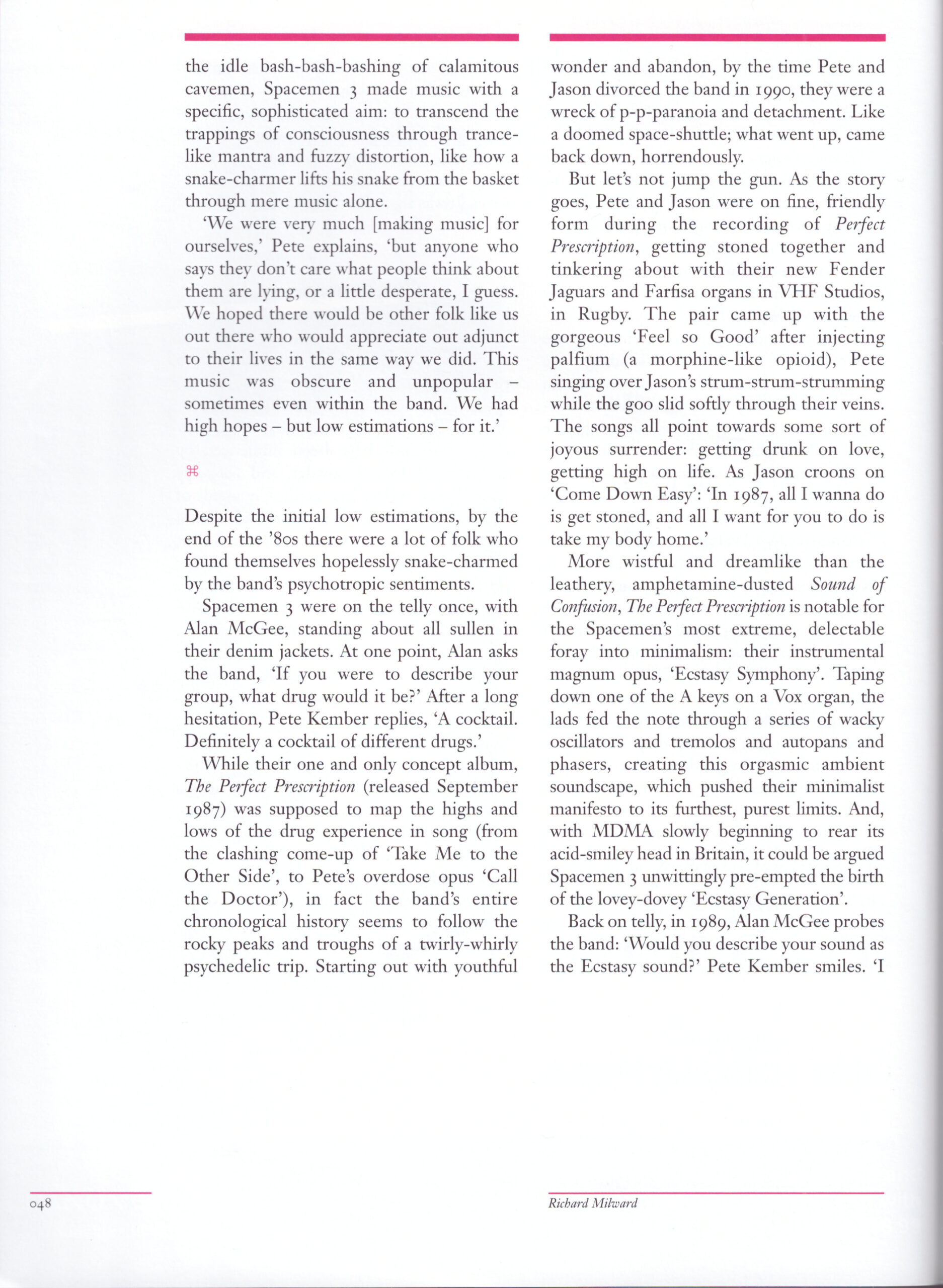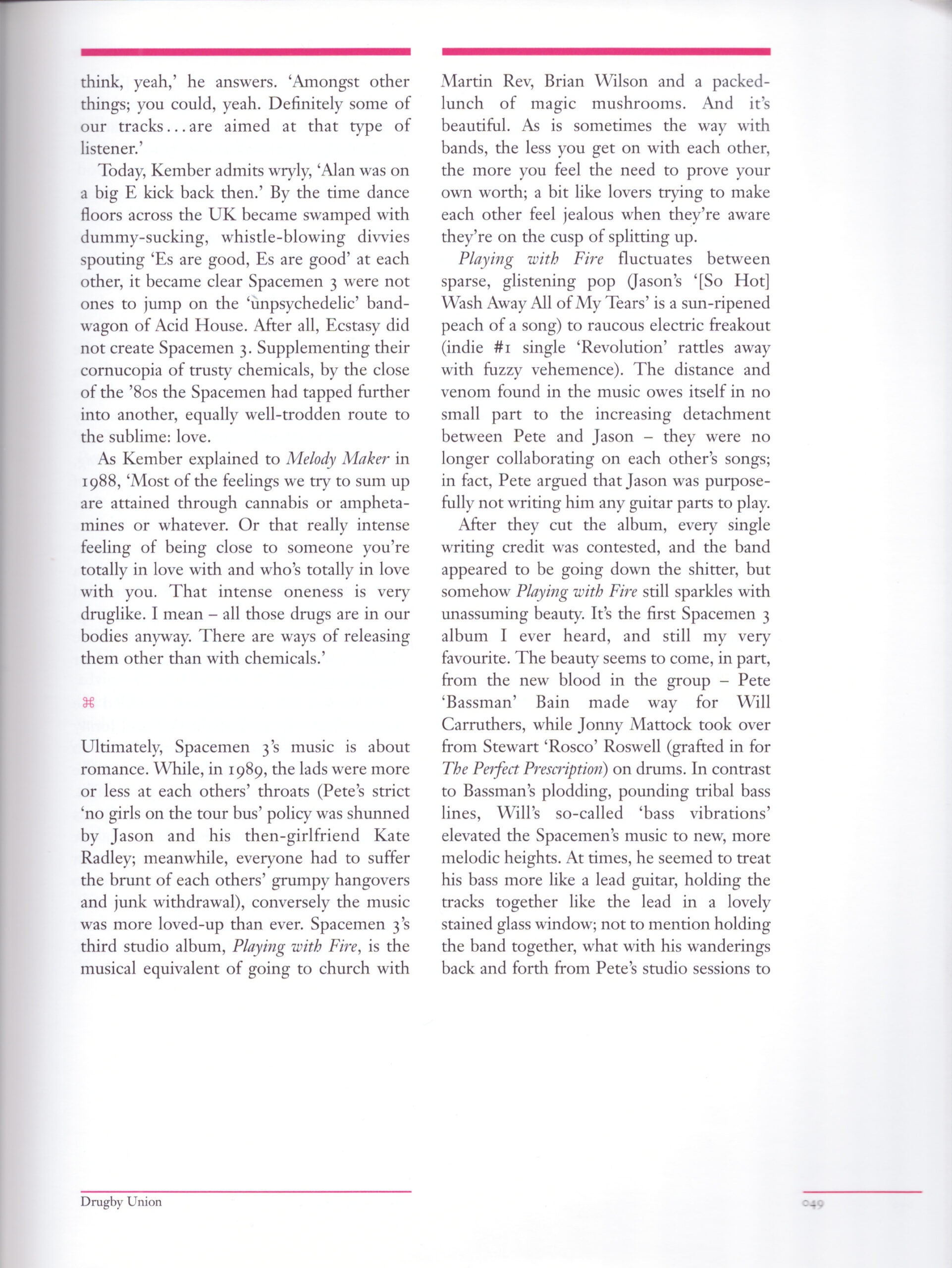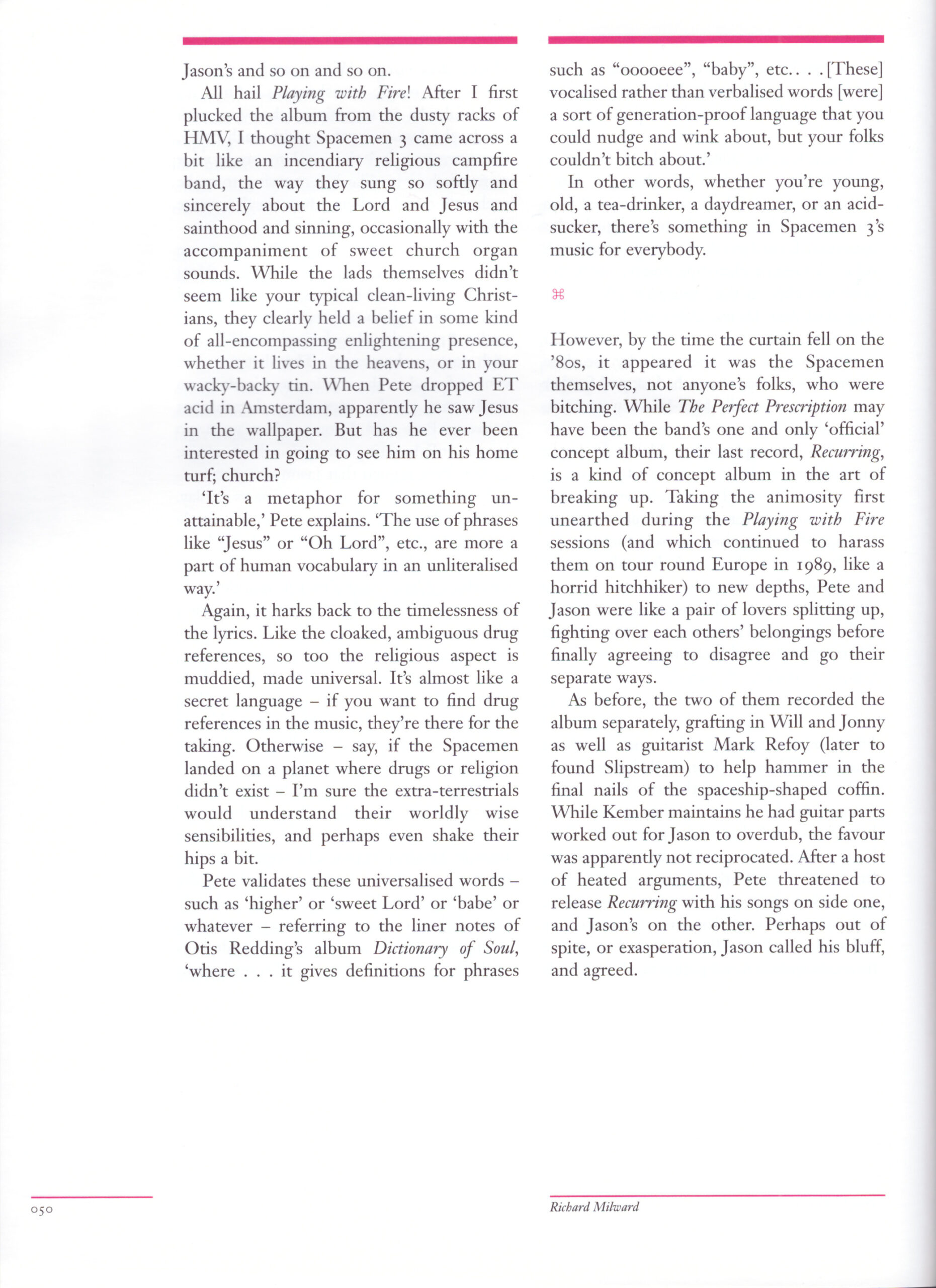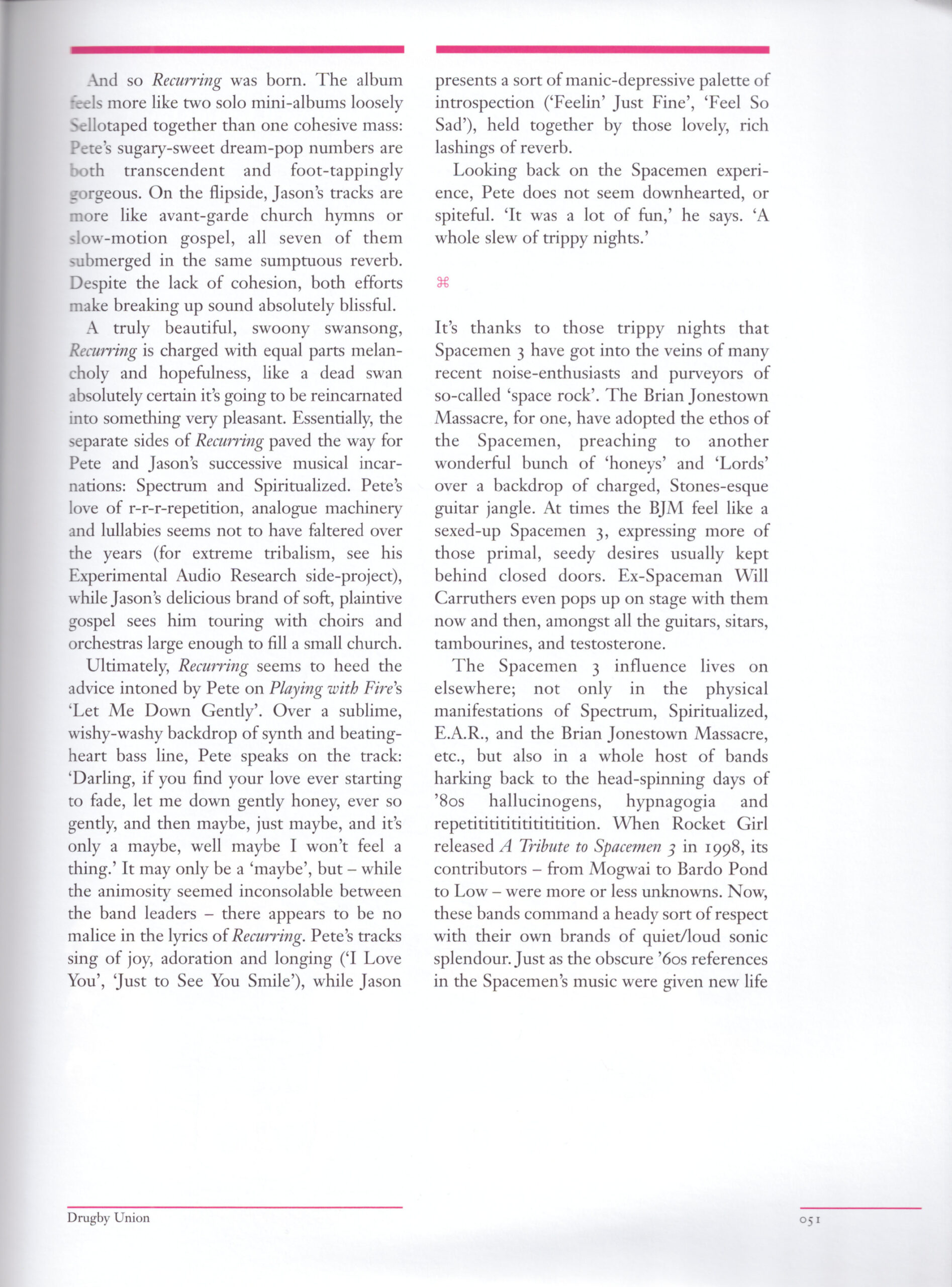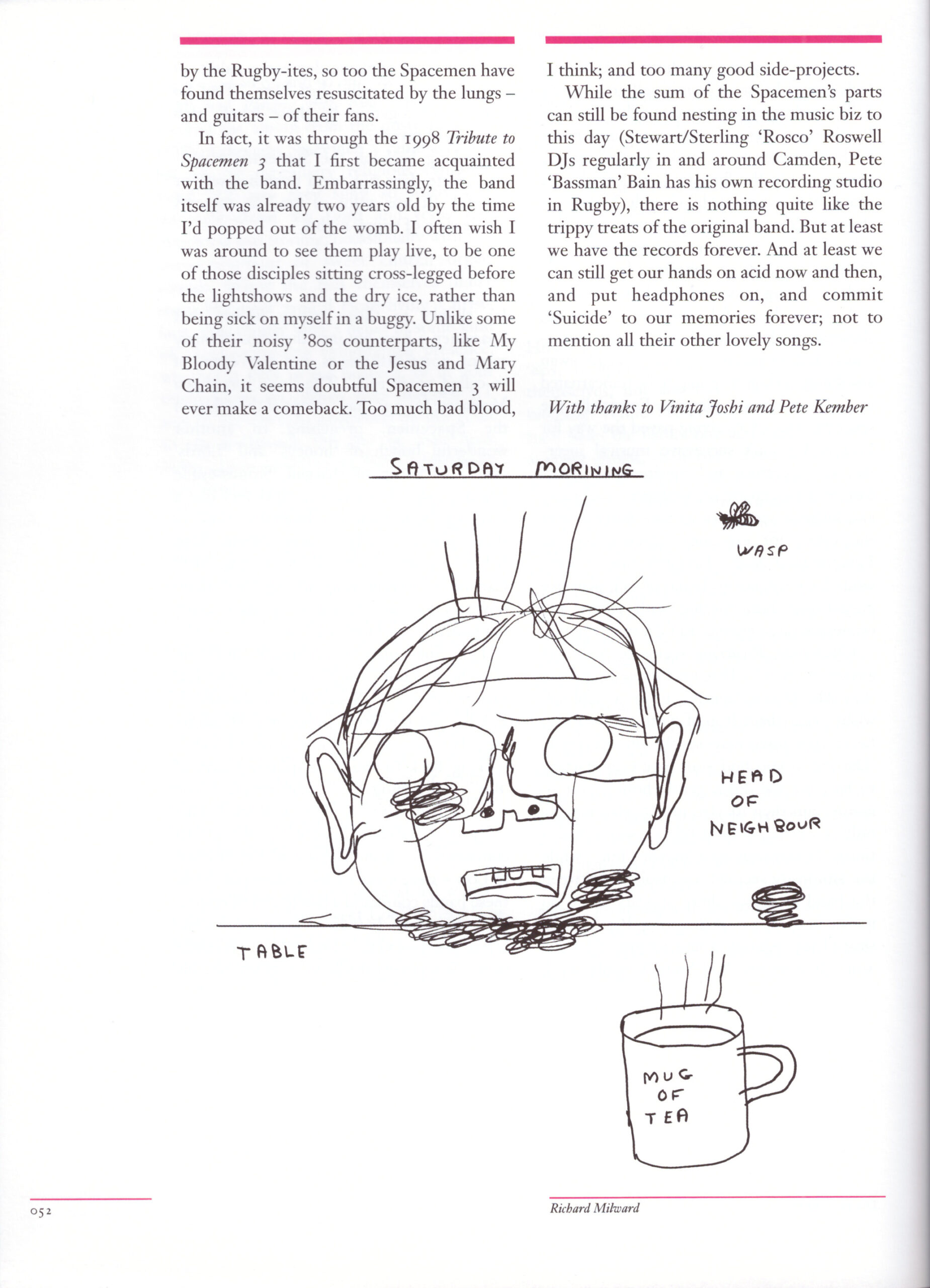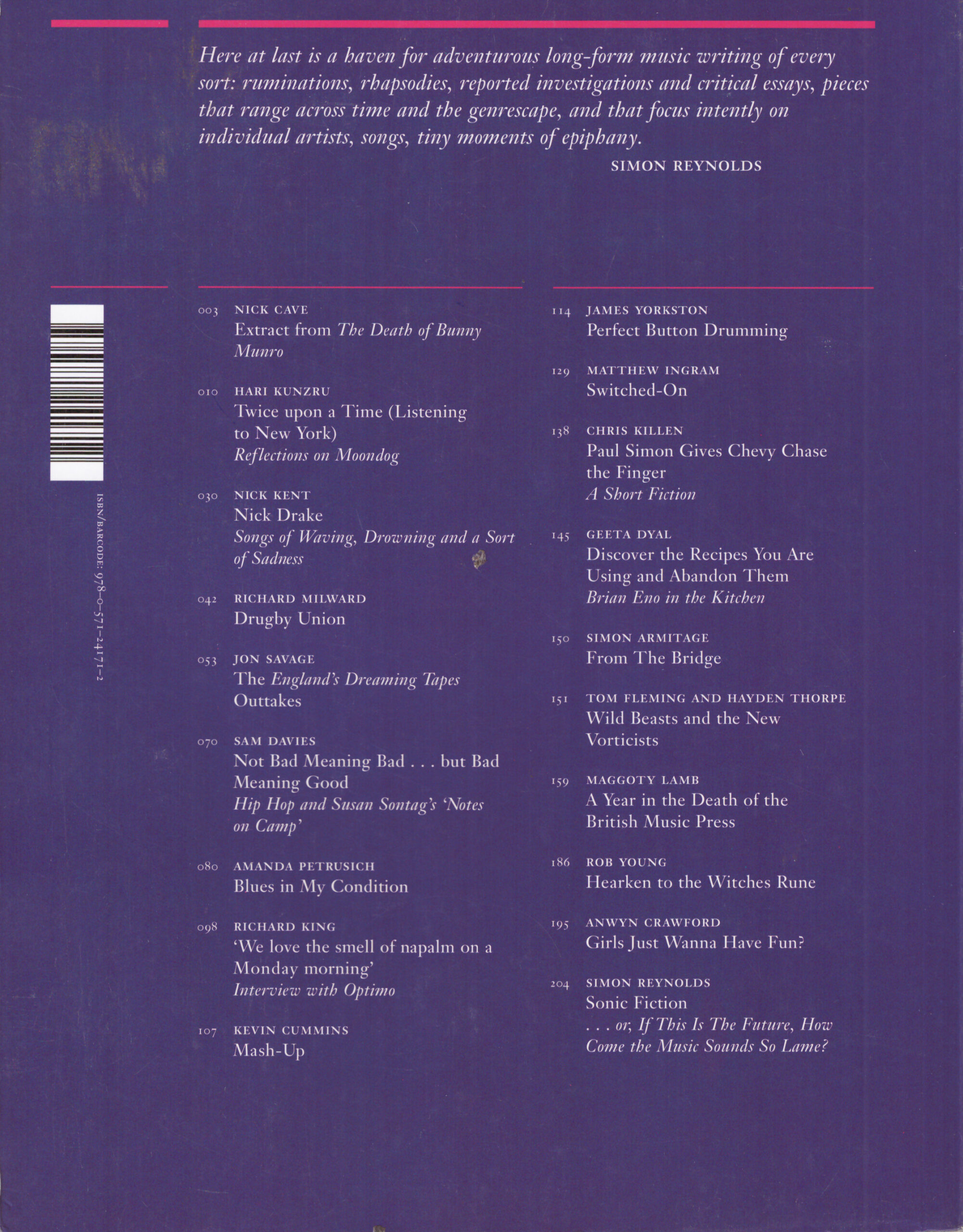Richard Milward – Drugby Union
⌘
Drugs and music make a wonderful couple. Without wanting to sound like a soggy-eyed grandmother-in-law, it’s like they really were made for each other. The best drugs make the best sounds sound even better, like replacing your old worn-out ears with new, state-of-the-art surround-sound speakers for a few sacred hours.
Along with drinking cups of tea and daydreaming, taking drugs and listening to music is one of my all-time favourite pastimes. Acid transforms Donovan into the most gorgeous, hilarious twee psychedelia, putting me in stitches just by the way he rolls his Rs. Ecstasy and the Beatles makes me fall hopelessly in love, Cupid-like, with whoever happens to be nearby, especially if they like the Beatles too. But it’s Spacemen 3, with their Timothy Leary-like guidance and delightful hypnagogic drones, who turn taking drugs into a riotous, near-religious experience.
A very long time ago, the hole in the middle of Karl Marx’s beard said, ‘Religion is the opiate of the masses.’ A bit more recently between the years of our Lord 1982 and 1990, to be precise – Spacemen 3 were the opiate for a modest number of drone-drenched disciples. Nowadays, more people get their kicks from drugs and music than from the stuffy shackles of religion – although, essentially, the experience is quite similar; going out every weekend in your best clobber, singing along to enlightening, happy-clappy music, receiving wine, getting scolded and told what to do by men in smart black suits. Likewise, both getting lashed and going to church have that cruel ability to make you wake up feeling a bit guilty now and then.
With all the references to ‘God’ and ‘the Lord’ in their lyrics, Spacemen 3 seemed a bit like sonic shamans themselves, blending heavenly, hypnotic guitar and synth with mantra-like melodies whispered lovingly in your inner ear. Often, people would sit on the floor at their gigs, as if in prayer, the altar-like amplifiers churning out layer upon layer of enlightening white lightning.
Spacemen 3 enjoyed sitting down at their gigs, too. Not ones for onstage amateur dramatics or daft cock-rock showmanship, the band delivered their sermons sitting on stools – a bit like your local dusty, folky church band, except with more intentional feedback, more stroboscopic brain-sizzling lightshows, and more songs about smack. They are a wonderful companion to any trip be it drug-fuelled or otherwise – transporting you softly to a strange world where you can walk and talk with Jesus, fall in love, and come down easy.
⌘
There are lots of marvellous, magical things about Spacemen 3. Born on the very same day (19 November 1965), by some cosmic law of attraction Pete ‘Sonic Boom’ Kember and Jason Pierce met and formed Spacemen 3 in 1982 at art college in Rugby, Warwickshire – the home of cement, radio masts, odd-shaped balls, and plentiful odd-shaped pills and potions. Affectionately known as ‘Drugby’, in the Eighties the town was awash cheapo narcotics. Wearing their musical influences on their sleeves (as well as the odd cheeky track-mark underneath), the lads started out making music combining the primal raw power of the Stooges with the rolling greased lightning of Krautrock. Their early demos (captured on For All the Fucked-Up Children Of This World We Give You Spacemen 3 and Taking Drugs To Make Music to Take Drugs To) seemed like the work of a hippyish Velvet Underground, Natty’s Neanderthal drumming summoning up the spirit of Mo Tucker, all the while Pete and Jason injecting their amps with sloppy melodic distortion in a similar vein to their moody sunglassed heroes, Reed and Cale.
At times, during the early days, Spacemen 3 might have been seen as a sort of cosmic covers band – reworking and remodelling the musical threads of their idols (the MC5, the Red Krayola, the 13th Floor Elevators, etc.) into new, woolly sonic tapestries. It’s perhaps due to these – then obscure – ’60s influences that, in 1982, the band sounded like nothing else around. Set against their contemporaries (for instance, it took the Jesus and Mary Chain until 1985 to treat us to their delicious PsychoCandy, and it was not until 1986 that alleged Spacemen 3 ‘rip-offs’ Loop formed in London), Spacemen 3 were more like artists reinterpreting the work of their favourite Old Masters, rather than trying in vain to reinvent the colour-wheel.
⌘
On a chilly Friday evening in autumn, me and a pal took some LSD out from its hiding place in the back of To Kill a Mockingbird. The acid had blue suns on it. A few hours later, after the obligatory giggling along to Donovan, I decided to dash home before the effects wore off, to surrender my surround-sound speaker-ears completely to Spacemen 3. It seemed like the decent thing to do, since I was limbering up to write an essay about them and all.
Laid out perfectly horizontally on my bed, I figured the best place to start was to stick on both versions of ‘Suicide’ (the band’s notorious one-chord metallic noise-orgy) off the remastered Playing With Fire album, on headphones. Since intense tear-jerking laughter had been the theme of the night’s trip, as soon as the song kicked in, both me and the guitars were cackling uncontrollably. Instant pleasure! At times it was like being serenaded by a lynch mob of randy robots squealing ‘DANGER DANGER DANGER DANGER DANGER’, the music wahwahwahwahwahwahwahwahing away, rising rising rising to the point of a supersonic starburst. Oh yes!
You see, it’s the tones – not specifically the notes – that ooze pleasure in Spacemen 3’s music. Applying a strict, puritan ethic of ‘less is more’ (the band’s legendary manifesto was ‘Three chords good, two chords better, one chord best’, so says Chris Barrus, in the Live in Europe 1989 liner notes), the Spacemen eschewed fancy fretwork for jaw-dropping simplicity. In their infancy, the band were more or less shunned for their particular brand of repetitive psychedelia (whereby songs could go on for twenty-odd minutes, the lads seemingly stuck in a one-note groove, like statuettes in a broken music-box), but went on to inspire legions of fans and bands who enjoy getting high on the crest of a steadfast soundwave.
⌘
My Friday night of ‘Suicide’ was truly heavenly, though perhaps the only daft thing about doing acid is its ability to turn you into a freakish insomniac. By five or six in the morning, I was still wide awake, gazing zombie-like at the photos in the middle of Erik Morse’s newish Spacemen 3 biography. The blue suns had already begun to wear off and set in the dusky lower sanctums of my brain, leaving me with sore limbs, sticky trip-fingers, and heavy bushbaby eyeballs. As is always the case with LSD, once you get to that stage, you’re just sat there wishing the visions would come back. Music – and life in general – seems so much blander and sad.
Head stinging, I found myself staring listlessly at this photo of a young Pete and Jason, sat together on some Rugby railing or other. Yawn yawn! I was just about to slip into the shallow waters of sleep when – I kid you not – I saw Pete hop off the railing! Admittedly, the acid was too weak now to make him do anything else exciting (like hop downstairs and make me a nice cup of tea), but the fact that he’d made himself known to me in such a dire druggy malady made me chuckle again.
Then, finally, I dropped off to peeps.
⌘
I became acquainted with Pete Kember again a couple of months later, this time by a similarly mystical process: the internet. Still buzzing off the randy robot chorus of ‘Suicide’ (itself more a homage to the art-rock duo of the same name, than the art of topping yourself), I asked Pete if he finds certain drugs especially helpful – and others – to the creative particularly detrimental process. After all, it was Pete who came up with the title Taking Drugs to Make Music to Take Drugs to, which begs the question: which drugs does Pete like to take to make music to take drugs to?
‘Different strokes for different folks,’ he replied. ‘I dunno, it’s very personal, I guess. DMT I find awe-inspiring and very stimulating creatively. I think smack can be, in its own way. Coke – sure. LSD/mushrooms – definitely. Speed – of course. In the same way though, any of these can be destructive to creativity. It’s a fine balance – and I firmly believe a reasonable route to the sublime – BUT only with adherences to a certain respect for these things.’
It’s important to stress here that Spacemen 3 were far from being wastrels. The lads may have been explicit about what drugs they’ve been on in their interviews, but only because journalists enjoyed hounding them about it, coaxing them into being controversial. Honesty is far more of a virtue than drug-taking is a sin, after all – from the very outset, all the Spacemen tried to do was tell the truth.
‘I don’t subscribe to the “all drugs are bad and dangerous” thing,’ stresses Pete. ‘I take each on their own merits and downsides, and fully realise that they have both.’
Taking Drugs… aside, the band was far less chatty about narcotics in their music. In fact, the lyrics retain an intentional ambiguity – when they sing about ‘getting high’ or ‘losing touch’ with their minds, anyone who has ever been in love or felt utterly alone can relate as much to the lyrics as your average pot-headed hippy.
Even the most heartless of humans are interested in emotions–and drugs are interested in heightening them for us. In turn, Spacemen 3 were interested in condensing these feelings for us into song, like rock-and-roll research scientists. Ultimately, it is the timelessness of these songs – and the emotions wrapped up in them – which has ensured the band’s longevity.
Admittedly, ‘Walkin’ with Jesus’ (the band’s wondrous first single, released in November 1986) originally contained the lyric ‘So listen sweet Lord please forgive me my sins, cos I can’t stand this life without sweet heroin’; however, after a bit of deliberation, the band substituted ‘sweet heroin’ for the more universal ‘all of these things’, exemplifying their wish never to alienate the listener. In other words, they didn’t care about forcing drugs down the listener’s throat; only their own, in private, for their own ends.
Incidentally, the reference to ‘sweet heroin’ in ‘Walkin’ with Jesus’ stemmed from some obligatory writings Pete penned in a clinic for addiction outside Rugby. ‘It was analogising life with drugs to drinking water, or drinking orange squash!’ explains Pete, who has been on and off the drug for much of his life. ‘[But] it soon became apparent that if I wanted to get out of the clinic and avoid sectioning, that proselytising about drugs was not going to work. I met some interesting characters in there: drug burnouts, alcoholics, bored house-wives. It was a good intro to the music biz… ‘
⌘
By the latter stages of 1986, Spacemen 3’s lift-off into the music biz was well underway. Their first full-length album, Sound of Confusion, was released in July of that year; a record apparently ‘written about taking speed’. From Raw Power to Metal Machine Music, some of the most wonderful, ear-splitting records have been influenced by that white-coloured powder, and Sound of Confusion is no less masterful. Chockfull of churning, gurning distortion, the album seems like a distant nephew of the Velvet Underground’s White Light/White Heat, the primitive guitars smothering the delicate, sentimental melodies with the softest of fuzzy pillows. However, unlike the VU – who notoriously didn’t like each other very much when they were recording White Light/White Heat – Sound of Confusion captures four young friends (Pete, Jason, Pete ‘Bassman’ Bain and drummer Nicholas ‘Natty’ Brooker) guiding each other blindly on their maiden sonic voyage, with only a few meagre chords packed in their suitcases.
In the early days, perhaps the ‘Three chords good, two chords better, one chord best’ manifesto was just a convenient cover-up for a lack of competence. However, listening to Sound of Confusion, the strict repetition seems less a crutch, more the crux of an extraordinary idealism. As opposed to the idle bash-bash-bashing of calamitous cavemen, Spacemen 3 made music with a specific, sophisticated aim: to transcend the trappings of consciousness through trance-like mantra and fuzzy distortion, like how a snake-charmer lifts his snake from the basket through mere music alone.
‘We were very much [making music] for ourselves,’ Pete explains, ‘but anyone who says they don’t care what people think about them are lying, or a little desperate, I guess. We hoped there would be other folk like us out there who would appreciate out adjunct to their lives in the same way we did. This music was obscure and unpopular sometimes even within the band. We had high hopes – but low estimations – for it.’
⌘
Despite the initial low estimations, by the end of the ’80s there were a lot of folk who found themselves hopelessly snake-charmed by the band’s psychotropic sentiments.
Spacemen 3 were on the telly once, with Alan McGee, standing about all sullen in their denim jackets. At one point, Alan asks the band, ‘If you were to describe your group, what drug would it be?’ After a long hesitation, Pete Kember replies, ‘A cocktail. Definitely a cocktail of different drugs.’
While their one and only concept album, The Perfect Prescription (released September 1987) was supposed to map the highs and lows of the drug experience in song (from the clashing come-up of ‘Take Me to the Other Side’, to Pete’s overdose opus ‘Call the Doctor’), in fact the band’s entire chronological history seems to follow the rocky peaks and troughs of a twirly-whirly psychedelic trip. Starting out with youthful wonder and abandon, by the time Pete and Jason divorced the band in 1990, they were a wreck of p-p-paranoia and detachment. Like a doomed space-shuttle; what went up, came back down, horrendously.
But let’s not jump the gun. As the story goes, Pete and Jason were on fine, friendly form during the recording of Perfect Prescription, getting stoned together and tinkering about with their new Fender Jaguars and Farfisa organs in VHF Studios, in Rugby. The pair came up with the gorgeous ‘Feel so Good’ after injecting palfium (a morphine-like opioid), Pete singing over Jason’s strum-strum-strumming while the goo slid softly through their veins. The songs all point towards some sort of joyous surrender: getting drunk on love, getting high on life. As Jason croons on ‘Come Down Easy’: ‘In 1987, all I wanna do is get stoned, and all I want for you to do is take my body home.’
More wistful and dreamlike than the leathery, amphetamine-dusted Sound of Confusion, The Perfect Prescription is notable for the Spacemen’s most extreme, delectable foray into minimalism: their instrumental magnum opus, ‘Ecstasy Symphony’. Taping down one of the A keys on a Vox organ, the lads fed the note through a series of wacky oscillators and tremolos and autopans and phasers, creating this orgasmic ambient soundscape, which pushed their minimalist manifesto to its furthest, purest limits. And, with MDMA slowly beginning to rear its acid-smiley head in Britain, it could be argued Spacemen 3 unwittingly pre-empted the birth of the lovey-dovey ‘Ecstasy Generation’.
Back on telly, in 1989, Alan McGee probes the band: ‘Would you describe your sound as the Ecstasy sound?’ Pete Kember smiles. ‘I think, yeah,’ he answers. ‘Amongst other things; you could, yeah. Definitely some of our tracks … are aimed at that type of listener. ‘
Today, Kember admits wryly, ‘Alan was on a big E kick back then.’ By the time dance floors across the UK became swamped with dummy-sucking, whistle-blowing divvies spouting ‘Es are good, Es are good’ at each other, it became clear Spacemen 3 were not ones to jump on the ‘unpsychedelic’ bandwagon of Acid House. After all, Ecstasy did not create Spacemen 3. Supplementing their cornucopia of trusty chemicals, by the close of the ’80s the Spacemen had tapped further into another, equally well-trodden route to the sublime: love.
As Kember explained to Melody Maker in 1988, ‘Most of the feelings we try to sum up are attained through cannabis or amphetamines or whatever. Or that really intense feeling of being close to someone you’re totally in love with and who’s totally in love with you. That intense oneness is very druglike. I mean – all those drugs are in our bodies anyway. There are ways of releasing them other than with chemicals.’
⌘
Ultimately, Spacemen 3’s music is about romance. While, in 1989, the lads were more or less at each others’ throats (Pete’s strict ‘no girls on the tour bus’ policy was shunned by Jason and his then-girlfriend Kate Radley; meanwhile, everyone had to suffer the brunt of each others’ grumpy hangovers and junk withdrawal), conversely the music was more loved-up than ever. Spacemen 3 ‘s third studio album, Playing With Fire, is the musical equivalent of going to church with Martin Rev, Brian Wilson and a packed-lunch of magic mushrooms. And it’s beautiful. As is sometimes the way with bands, the less you get on with each other, the more you feel the need to prove your own worth; a bit like lovers trying to make each other feel jealous when they’re aware they’re on the cusp of splitting up.
Playing With Fire fluctuates between sparse, glistening pop (Jason’s ‘[So Hot] Wash Away All of My Tears’ is a sun-ripened peach of a song) to raucous electric freakout (indie #1 single ‘Revolution’ rattles away with fuzzy vehemence). The distance and venom found in the music owes itself in no small part to the increasing detachment between Pete and Jason – they were no longer collaborating on each other’s songs; in fact, Pete argued that Jason was purposefully not writing him any guitar parts to play.
After they cut the album, every single writing credit was contested, and the band appeared to be going down the shitter, but somehow Playing With Fire still sparkles with unassuming beauty. It’s the first Spacemen 3 album I ever heard, and still my very favourite. The beauty seems to come, in part, from the new blood in the group – Pete ‘Bassman’ Bain made way for Will Carruthers, while Jonny Mattock took over from Stewart ‘Rosco’ Roswell (grafted in for The Perfect Prescription) on drums. In contrast to Bassman’s plodding, pounding tribal bass lines, Will’s so-called ‘bass vibrations’ elevated the Spacemen’s music to new, more melodic heights. At times, he seemed to treat his bass more like a lead guitar, holding the tracks together like the lead in a lovely stained glass window; not to mention holding the band together, what with his wanderings back and forth from Pete’s studio sessions to Jason’s and so on and so on.
All hail Playing With Fire! After I first plucked the album from the dusty racks of HMV, I thought Spacemen 3 came across a bit like an incendiary religious campfire band, the way they sung so softly and sincerely about the Lord and Jesus and sainthood and sinning, occasionally with the accompaniment of sweet church organ sounds. While the lads themselves didn’t seem like your typical clean-living Christians, they clearly held a belief in some kind of all-encompassing enlightening presence, whether it lives in the heavens, or in your wacky-backy tin. When Pete dropped ET acid in Amsterdam, apparently he saw Jesus in the wallpaper. But has he ever been interested in going to see him on his home turf; church?
‘It’s a metaphor for something unattainable,’ Pete explains. ‘The use of phrases like “Jesus” or “Oh Lord”, etc., are more a part of human vocabulary in an unliteralised way. ‘
Again, it harks back to the timelessness of the lyrics. Like the cloaked, ambiguous drug references, so too the religious aspect is muddied, made universal. It’s almost like a secret language – if you want to find drug references in the music, they’re there for the taking. Otherwise – say, if the Spacemen landed on a planet where drugs or religion didn’t exist – I’m sure the extra-terrestrials would understand their worldly wise sensibilities, and perhaps even shake their hips a bit.
Pete validates these universalised words – such as ‘higher’ or ‘sweet Lord’ or ‘babe’ or – referring to the liner notes of whatever Otis Redding’s album Dictionary of Soul ‘where . . . , it gives definitions for phrases such as “ooooeee”, “baby”, etc.. . . [These] vocalised rather than verbalised words [were] a sort of generation-proof language that you could nudge and wink about, but your folks couldn’t bitch about.’
In other words, whether you’re young, old, a tea-drinker, a daydreamer, or an acid-sucker, there’s something in Spacemen 3 ‘s music for everybody.
⌘
However, by the time the curtain fell on the ’80s, it appeared it was the Spacemen themselves, not anyone’s folks, who were bitching. While The Perfect Prescription may have been the band’s one and only ‘official’ concept album, their last record, Recurring, is a kind of concept album in the art of breaking up. Taking the animosity first unearthed during the Playing With Fire sessions (and which continued to harass them on tour round Europe in 1989, like a horrid hitchhiker) to new depths, Pete and Jason were like a pair of lovers splitting up, fighting over each others’ belongings before finally agreeing to disagree and go their separate ways.
As before, the two of them recorded the album separately, grafting in WIII and Jonny as well as guitarist Mark Refoy (later to found Slipstream) to help hammer in the final nails of the spaceship-shaped coffin. While Kember maintains he had guitar parts worked out for Jason to overdub, the favour was apparently not reciprocated. After a host of heated arguments, Pete threatened to release Recurring with his songs on side one, and Jason’s on the other. Perhaps out of spite, or exasperation, Jason called his bluff, and agreed.
And so Recurring was born. The album feels more like two solo mini-albums loosely Sellotaped together than one cohesive mass: Pete’s sugary-sweet dream-pop numbers are both transcendent and foot-tappingly gorgeous. On the flipside, Jason’s tracks are more like avant-garde church hymns or slow-motion gospel, all seven of them submerged in the same sumptuous reverb. Despite the lack of cohesion, both efforts make breaking up sound absolutely blissful.
A truly beautiful, swoony swansong, Recurring is charged with equal parts melancholy and hopefulness, like a dead swan absolutely certain it’s going to be reincarnated into something very pleasant. Essentially, the separate sides of Recurring paved the way for Pete and Jason’s successive musical incarnations: Spectrum and Spiritualized. Pete’s love of r-r-r-repetition, analogue machinery and lullabies seems not to have faltered over the years (for extreme tribalism, see his Experimental Audio Research side-project), while Jason’s delicious brand of soft, plaintive gospel sees him touring with choirs and orchestras large enough to fill a small church.
Ultimately, Recurring seems to heed the advice intoned by Pete on Playing With Fire‘s ‘Let Me Down Gently’. Over a sublime, wishy-washy backdrop of synth and beating-heart bass line, Pete speaks on the track: ‘Darling, if you find your love ever starting to fade, let me down gently honey, ever so gently, and then maybe, just maybe, and it’s only a maybe, well maybe I won’t feel a thing.’ It may only be a ‘maybe’, but – while the animosity seemed inconsolable between the band leaders – there appears to be no malice in the lyrics of Recurring. Pete’s tracks sing of joy, adoration and longing (‘I Love You’, ‘Just to See You Smile’), while Jason presents a sort of manic-depressive palette of introspection (‘Feelin’ Just Fine’, ‘Feel So Sad’), held together by those lovely, rich lashings of reverb.
Looking back on the Spacemen experience, Pete does not seem downhearted, or spiteful. ‘It was a lot of fun,’ he says. ‘A whole slew of trippy nights.’
⌘
It’s thanks to those trippy nights that Spacemen 3 have got into the veins of many recent noise-enthusiasts and purveyors of so-called ‘space rock’. The Brian Jonestown Massacre, for one, have adopted the ethos of the Spacemen, preaching to another wonderful bunch of ‘honeys’ and ‘Lords’ over a backdrop of charged, Stones-esque guitar jangle. At times the BJM feel like a sexed-up Spacemen 3, expressing more of those primal, seedy desires usually kept behind closed doors. Ex-Spaceman Will Carruthers even pops up on stage with them now and then, amongst all the guitars, sitars, tambourines, and testosterone.
The Spacemen 3 influence lives on elsewhere; not only in the physical manifestations of Spectrum, Spiritualized, E.A.R., and the Brian Jonestown Massacre, etc., but also in a whole host of bands harking back to the head-spinning days of ’80s hallucinogens, hypnagogia and repetititititititititition. When Rocket Girl released A Tribute to Spacemen 3 in 1998, its contributors – from Mogwai to Bardo Pond to Low – were more or less unknowns. Now, these bands command a heady sort of respect with their own brands of quiet/loud sonic splendour. Just as the obscure ’60s references in the Spacemen’s music were given new life by the Rugby-ites, so too the Spacemen have found themselves resuscitated by the lungs – and guitars – of their fans.
In fact, it was through the 1998 Tribute to Spacemen 3 that I first became acquainted with the band. Embarrassingly, the band itself was already two years old by the time I’d popped out of the womb. I often wish I was around to see them play live, to be one of those disciples sitting cross-legged before the lightshows and the dry ice, rather than being sick on myself in a buggy. Unlike some of their noisy ’80s counterparts, like My Bloody Valentine or the Jesus and Mary Chain, it seems doubtful Spacemen 3 will ever make a comeback. Too much bad blood, I think; and too many good side-projects.
While the sum of the Spacemen’s parts can still be found nesting in the music biz to this day (Stewart/Sterling ‘Rosco’ Roswell DJs regularly in and around Camden, Pete ‘Bassman’ Bain has his own recording studio in Rugby), there is nothing quite like the trippy treats of the original band. But at least we have the records forever. And at least we can still get our hands on acid now and then, and put headphones on, and commit ‘Suicide’ to our memories forever; not to mention all their other lovely songs.
With thanks to Vinita Joshi and Pete Kember
